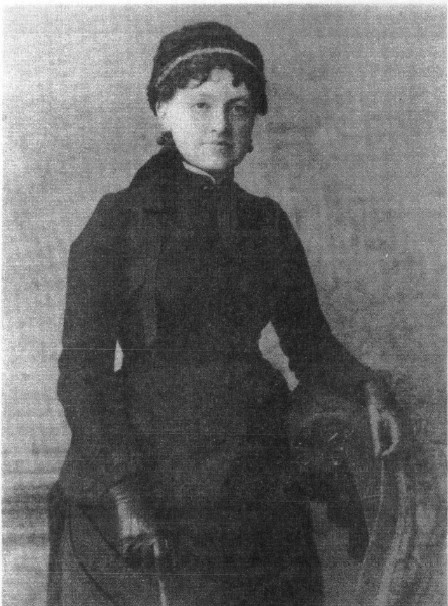
This is Annie McClure Hitchcock as a young woman. Thanks to the wonderful research by Susan O’Connor Davis and by a diligent relative writing in the Chicago Genealogical Society journal, I’ve learned so much about a woman I knew nothing about. I was poking through the University of Chicago archives and spotted her in a photo sitting next to John D. Rockefeller and wondered who might have gotten the prominent seat.
Her story is the story of the transformation of Chicago from a frontier village to a booming world-famous metropolis and the out-sized influence the early settlers had in shaping the city’s institutions. She deserves a multi-part post. The first part of her life wasn’t that remarkable, but I find it fun to try to picture how different things were when she was young.
Her parents were very early settlers. Her father was Scots-Irish from Ballywalter, Ireland. He came to the U.S. in 1826. He soon married, but his health was not good, so, hearing that Illinois had a mild climate and healing breezes (!!), he moved his family and a large library of books from Philadelphia to the frontier—a boat to Albany, New York, a canal boat west on the Erie Canal, a sailboat on the Great Lakes, to the area of Fort Dearborn. He built the first frame house in Lake County in 1837. The farm went through a series of crop failures in the brutal weather and in four years he was dead. Annie was two.
Her young mother and the five children moved to land they had at Jackson and Sherman Streets, where the Board of Trade is now. The oldest boy worked for the newspaper The Prairie Farmer, until he died of cholera at the age of 16. The mother worked as a tailor. By 1853, the Michigan Southern Railroad wanted their cottage, and the family moved near to the first high school in Chicago for Annie to attend. Meanwhile, in 1854, Charles Hitchcock arrived in Chicago, 12 years her senior, a lawyer, and a Harvard graduate. At some point, perhaps in the Presbyterian church, Annie met Charles Hitchcock.
In 1859, while they were engaged, Charles took Annie and some friends on a ride to the far south of the city, which she remembered vividly (as quoted by Susan O’Connor Davis):
Leaving the city pavements at Twelfth Street, we struck across the prairie, with its velvety turf roads, and following the curve of the shore of Lake Michigan came to the enchanting ground of gravel ridges with deep loam hollows between which tell of receding waters. All of the ridges were decorated with oak trees and wild fruit trees and vines, with wild roses and hazel shrubbery beneath. . . . All the low land had a variety of willows, and every kind of flower that loves to have its feet in water, while the grass fields that stretched between the ridges were blue with violets. —Annie McClure Hitchcock, “Reminiscences of Kenwood in 1859”
Suddenly, Charles pointed out a roof “rising above a thick grove of oaks” and let her know that he owned it. He hadn’t lived there because it was too far from business. But after the railroad opened stops in Hyde Park then Kenwood, the city was no longer too far away. Annie and Charles moved to 4747 East Greenwood in 1861. They owned about eight acres where they had riding and carriage horses, two cows, chickens, and cabbage and potato patches—and a house for the gardener. They had a few neighbors—mostly professional people retreating to the countryside.
Davis quotes from Annie’s memoir:
“At the corner of Greenwood and Forty-seventh was another swamp, and for the first few years we drove out of our backyard at Forty-seventh and Woodlawn Avenue,” she continued, confirming the marshy conditions of the area. “I had the honor of naming Greenwood Avenue; indeed it was a green wood, much frequented by city children, bent on uprooting the wild flowers and gathering the hazelnuts and wild plums.”
Hitchcock’s law partner recalled that "Mr. Hitchcock's home life was a most happy one....His wife, to whom he was most tenderly attached, shared in his intellectual and social tastes…."This was a home 'beyond compare', from which radiated most gracious hospitality to rich and poor, the highest and the humblest." (quoted in Chicago Genealogical History 2004)
Annie was just getting going.
No comments:
Post a Comment